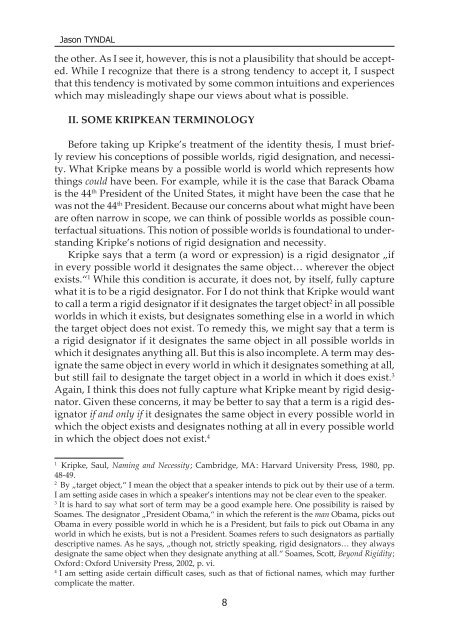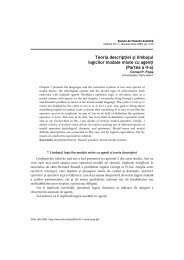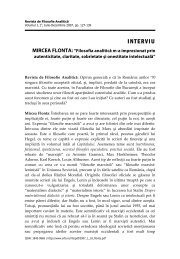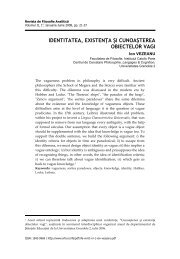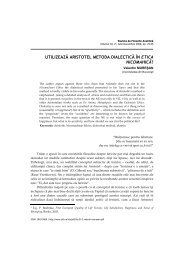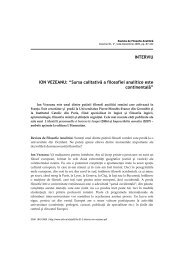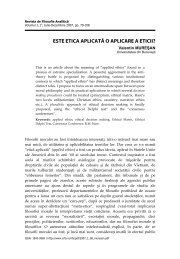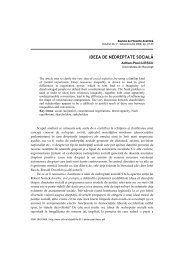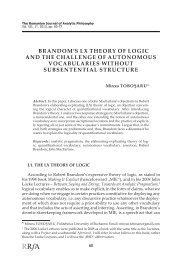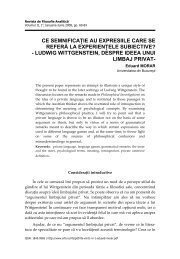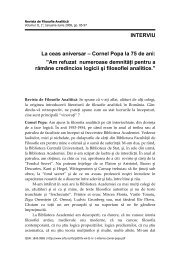AN ANALYSIS OF KRIpKE'S ARguMENT AgAINST THE IDENTITY ...
AN ANALYSIS OF KRIpKE'S ARguMENT AgAINST THE IDENTITY ...
AN ANALYSIS OF KRIpKE'S ARguMENT AgAINST THE IDENTITY ...
You also want an ePaper? Increase the reach of your titles
YUMPU automatically turns print PDFs into web optimized ePapers that Google loves.
Jason TYNDAL<br />
the other. As I see it, however, this is not a plausibility that should be accepted.<br />
While I recognize that there is a strong tendency to accept it, I suspect<br />
that this tendency is motivated by some common intuitions and experiences<br />
which may misleadingly shape our views about what is possible.<br />
II. SOME KRIPKE<strong>AN</strong> TERMINOLOGY<br />
Before taking up Kripke’s treatment of the identity thesis, I must briefly<br />
review his conceptions of possible worlds, rigid designation, and necessity.<br />
What Kripke means by a possible world is world which represents how<br />
things could have been. For example, while it is the case that Barack Obama<br />
is the 44 th President of the United States, it might have been the case that he<br />
was not the 44 th President. Because our concerns about what might have been<br />
are often narrow in scope, we can think of possible worlds as possible counterfactual<br />
situations. This notion of possible worlds is foundational to understanding<br />
Kripke’s notions of rigid designation and necessity.<br />
Kripke says that a term (a word or expression) is a rigid designator „if<br />
in every possible world it designates the same object… wherever the object<br />
exists.“ 1 While this condition is accurate, it does not, by itself, fully capture<br />
what it is to be a rigid designator. For I do not think that Kripke would want<br />
to call a term a rigid designator if it designates the target object 2 in all possible<br />
worlds in which it exists, but designates something else in a world in which<br />
the target object does not exist. To remedy this, we might say that a term is<br />
a rigid designator if it designates the same object in all possible worlds in<br />
which it designates anything all. But this is also incomplete. A term may designate<br />
the same object in every world in which it designates something at all,<br />
but still fail to designate the target object in a world in which it does exist. 3<br />
Again, I think this does not fully capture what Kripke meant by rigid designator.<br />
Given these concerns, it may be better to say that a term is a rigid designator<br />
if and only if it designates the same object in every possible world in<br />
which the object exists and designates nothing at all in every possible world<br />
in which the object does not exist. 4<br />
1<br />
Kripke, Saul, Naming and Necessity ; Cambridge, MA : Harvard University Press, 1980, pp.<br />
48‐49.<br />
2<br />
By „target object,“ I mean the object that a speaker intends to pick out by their use of a term.<br />
I am setting aside cases in which a speaker’s intentions may not be clear even to the speaker.<br />
3<br />
It is hard to say what sort of term may be a good example here. One possibility is raised by<br />
Soames. The designator „President Obama,“ in which the referent is the man Obama, picks out<br />
Obama in every possible world in which he is a President, but fails to pick out Obama in any<br />
world in which he exists, but is not a President. Soames refers to such designators as partially<br />
descriptive names. As he says, „though not, strictly speaking, rigid designators… they always<br />
designate the same object when they designate anything at all.“ Soames, Scott, Beyond Rigidity ;<br />
Oxford : Oxford University Press, 2002, p. vi.<br />
4<br />
I am setting aside certain difficult cases, such as that of fictional names, which may further<br />
complicate the matter.<br />
8


